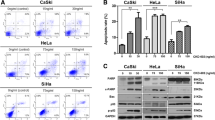Abstract
Small-molecule inhibitors targeted MAPK have been wildly used for some cancer therapeutics as a biologically viable model, but no one has been used for cervical caner. ERK1/2, one of MAPK kinases, is expressed high in cervical cancer tissue. The aim of the present study was to evaluate the effects of ERK1/2 inhibitor U0126 on proliferation and apoptosis of cervical cancer cells and appraise the correlated mechanism of the effects. In this study, the cell proliferation of Hela and C33A cervical cancer cells was tested by Cell Counting Kit-8 (CCK8) assay and cell counting after treated with ERK1/2 inhibitor U0126. The cell cycle and apoptosis were evaluated by flow cytometry (FCM). The protein levels of ERK1/2 and c-Fos and c-Jun were detected by Western blot. The results indicated that after down-regulating ERK1/2 proteins with the inhibitor U0126, Hela and C33A cells proliferation was inhibited, cell apoptosis was promoted, the proportions of G0/G1 stage in cell cycle increased, and G2/M stages decreased. After down-regulating ERK1/2 proteins of Hela and C33A cells, the expression levels of p–c-Fos protein decreased, while p–c-Jun protein increased. The results of this study indicated that ERK1/2 may promote the development of cervical cancer cells, suggesting ERK1/2 inhibitor may be used as an effective target for cervical cancer therapies working for. It might inhibit cervical cancer cells growth via regulating the transcription factors expression of c-Fos and c-Jun.





Similar content being viewed by others
References
Zhang B, Zhou AF, Zhu CC, et al. Risk factors for cervical cancer in rural areas of Wuhan China: a matched case-control study. Asian Pac J Cancer Prev. 2013;14:7595–600.
Rouzier R. Epidemiology and risk factors for cancer of the uterus. Rev Prat. 2014;64:774–9.
Feneyrolles C, Spenlinhauer A, Guiet L, Fauvel B, et al. Axl kinase as a key target for oncology: focus on small molecule inhibitors. Mol Cancer Ther. 2014;13:2141–8.
Smyth EC, Sclafani F, Cunningham D. Emerging molecular targets in oncology: clinical potential of MET/hepatocyte growth-factor inhibitors. Onco Targets Ther. 2014;7:1001–14.
Yun JI, Kim HR, Park H, et al. Small molecule inhibitors of the hedgehog signaling pathway for the treatment of cancer. Arch Pharm Res. 2012;35:1317–33.
Tasian SK, Teachey DT, Rheingold SR. Targeting the PI3K/mTOR pathway in pediatric hematologic malignancies. Front Oncol. 2014;4:108.
Miller CR, Oliver KE, Farley JH. MEK1/2 inhibitors in the treatment of gynecologic malignancies. Gynecol Oncol. 2014;133:128–37.
Yoon S, Seger R. The extracellular signal-regulated kinase: multiple substrates regulate diverse cellular functions. Growth Factors. 2006;24:21–44.
Roskoski R Jr. ERK1/2 MAP kinases: structure, function, and regulation. Pharmacol Res. 2012;66:105–43.
Pan F, Hong LQ. Insulin promotes proliferation and migration of breast cancer cells through the extracellular regulated kinase pathway. Asian Pac J Cancer Prev. 2014;15:6349–52.
El-Baba C, Mahadevan V, Fahlbusch FB, et al. Thymoquinone-induced conformational changes of PAK1 interrupt prosurvival MEK-ERK signaling in colorectal cancer. Mol Cancer. 2014;13:201.
Song X, Wang Y, Du H, et al. Overexpression of HepaCAM inhibits cell viability and motility through suppressing nucleus translocation of androgen receptor and ERK signaling in prostate cancer. Prostate. 2014;74:1023–33.
Lu Z, Ding L, Hong H, et al. Claudin-7 inhibits human lung cancer cell migration and invasion through ERK/MAPK signaling pathway. Exp Cell Res. 2011;317:1935–46.
Deschenes-Simard X, Kottakis F, Meloche S, et al. ERKs in cancer: friends or foes? Cancer Res. 2014;74:412–9.
Cai DH, Wang D, Keefer J, et al. C/EBP alpha: AP-1 leucine zipper heterodimers bind novel DNA elements, activate the PU.1 promoter and direct monocyte lineage commitment more potently than C/EBP alpha homodimers or AP-1. Oncogene. 2008;27:2772–9.
Shaulian E, Karin M. AP-1 as a regulator of cell life and death. Nat Cell Biol. 2002;4:E131–6.
Manimala NJ, Frost CD, Lane ML, et al. Cardiac hormones target nuclear oncogenes c-Fos and c-Jun in carcinoma cells. Eur J Clin Invest. 2013;43:1156–62.
Santarpia L, Lippman SM, El-Naggar AK. Targeting the MAPK-RAS-RAF signaling pathway in cancer therapy. Expert Opin Ther Targets. 2012;16:103–19.
Lee EK, Regenold WT, Shapiro P. Inhibition of aldose reductase enhances HeLa cell sensitivity to chemotherapeutic drugs and involves activation of extracellular signal-regulated kinases. Anticancer Drugs. 2002;13:859–68.
Wang X, Govind S, Sajankila SP, et al. Phenethyl isothiocyanate sensitizes human cervical cancer cells to apoptosis induced by cisplatin. Mol Nutr Food Res. 2011;55:1572–81.
Lorusso PM, Adjei AA, Varterasian M, et al. Phase I and pharmacodynamic study of the oral MEK inhibitor CI-1040 in patients with advanced malignancies. J Clin Oncol. 2005;23:5281–93.
Rinehart J, Adjei AA, Lorusso PM, et al. Multicenter phase II study of the oral MEK inhibitor, CI-1040, in patients with advanced non-small-cell lung, breast, colon, and pancreatic cancer. J Clin Oncol. 2004;22:4456–62.
LoRusso PM, Krishnamurthi SS, Rinehart JJ, et al. Phase I pharmacokinetic and pharmacodynamic study of the oral MAPK/ERK kinase inhibitor PD-0325901 in patients with advanced cancers. Clin Cancer Res. 2010;16:1924–37.
Yeh TC, Marsh V, Bernat BA, et al. Biological characterization of ARRY-142886 (AZD6244), a potent, highly selective mitogen-activated protein kinase kinase 1/2 inhibitor. Clin Cancer Res. 2007;13:1576–83.
Marampon F, Gravina GL, Popov VM, et al. Close correlation between MEK/ERK and Aurora-B signaling pathways in sustaining tumorigenic potential and radioresistance of gynecological cancer cell lines. Int J Oncol. 2014;44:285–94.
Hess J, Angel P, Schorpp-Kistner M. AP-1 subunits: quarrel and harmony among siblings. J Cell Sci. 2004;117:5965–73.
Prusty BK, Das BC. Constitutive activation of transcription factor AP-1 in cervical cancer and suppression of human papillomavirus (HPV) transcription and AP-1 activity in HeLa cells by curcumin. Int J Cancer. 2005;113:951–60.
Acknowledgments
This research is supported by the National Natural Science Foundation of China (Grant No. 81273157 and No. 30872166) and the Natural Science Foundation of Shanxi Province, China (Grant No. 2008011075-1).
Conflict of interest
The authors declare that they have no conflict of interest.
Author information
Authors and Affiliations
Corresponding author
Rights and permissions
About this article
Cite this article
Bai, L., Mao, R., Wang, J. et al. ERK1/2 promoted proliferation and inhibited apoptosis of human cervical cancer cells and regulated the expression of c-Fos and c-Jun proteins. Med Oncol 32, 57 (2015). https://doi.org/10.1007/s12032-015-0490-5
Received:
Accepted:
Published:
DOI: https://doi.org/10.1007/s12032-015-0490-5




